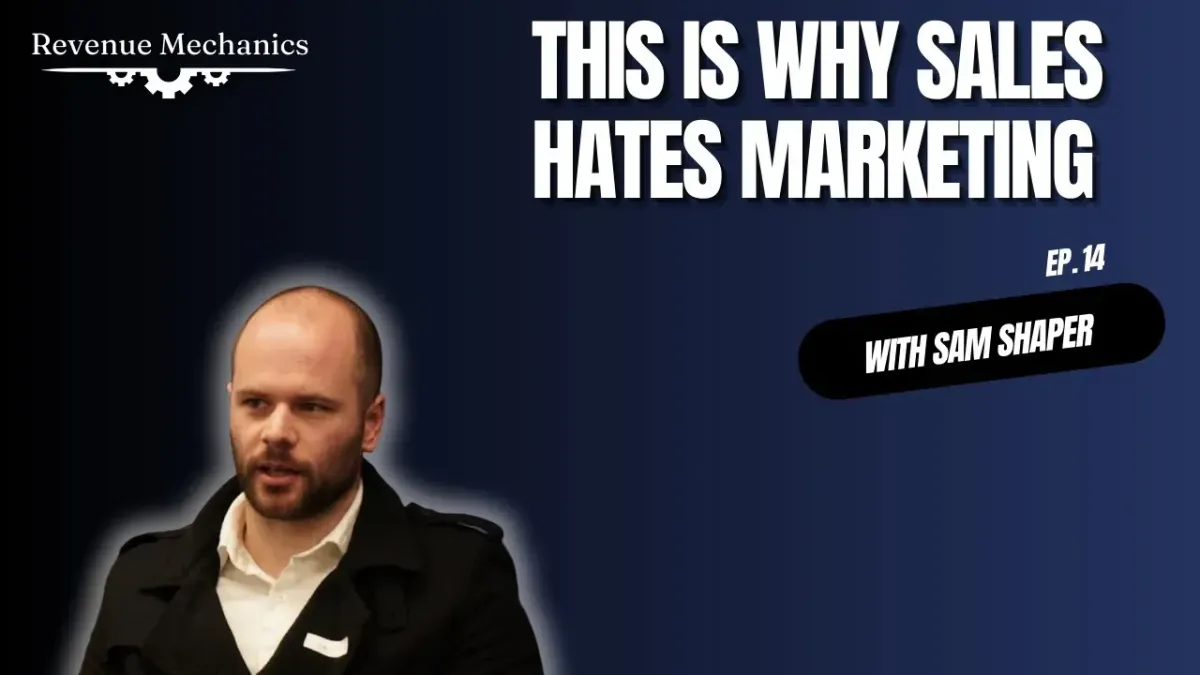
Why Sales Hates Marketing...
Scaling Sales Without the Chaos
The Reality of Revenue Growth
Before you start throwing money at sales hires or ad campaigns, ask yourself this: Is my revenue engine designed to scale, or am I just fueling chaos?
We often see founders treating revenue like a math problem—plug in more leads, add more reps, get more sales. But the truth is, growth isn’t linear when your foundation is broken. More fuel doesn’t help if the engine itself is inefficient.
Let’s dig into what really causes sales scale to stall—and what to do about it.
Misaligned Metrics, Misaligned Teams
Imagine trying to win a race with each wheel on your car spinning in a different direction. That’s what happens when departments run on misaligned KPIs.
Marketing chases the cheapest leads to hit MQL targets. SDRs book meetings without regard to quality. Sales get stuck closing unqualified prospects. Customer success picks up the pieces. Finance cuts costs without understanding the revenue engine. The result? Chaos.
To watch the training, click here. Otherwise, read on.
My Journey Through the Sales Maze
I started my sales career at a company that had already chewed through two sales teams before I arrived. I was tasked with 50 bookings a week and an 85% show rate—metrics that forced me to prioritize volume over quality. I saw firsthand how misaligned goals wrecked the business from the inside.
Later, when I was left to manage everything—booking, selling, onboarding—I scrapped the broken model and focused on quality. Fewer, better leads. Higher conversion. Happier clients. It worked. But when the company reverted to the old model and scaled the team again, everything collapsed.
Contrast that with another company I worked for, where I implemented a system focused on aligning marketing, sales, and success around a shared goal. The result? Eight-figure revenue, lower acquisition costs, and shorter sales cycles.
Scaling Isn't Just Hiring More
Most founders rely on outdated data models. Either:
Ad spend → Leads → Calls → Sales, or
Reps → Meetings → Revenue
These formulas ignore lead quality, intent, and market saturation. As you expand, your audience gets colder, not warmer. And if your system treats all leads equally, your reps waste time pitching to people who aren’t ready—or never will be.
Instead, think like a systems engineer. Where are the real inefficiencies? What sources consistently yield high-intent, high-value buyers?
Build a Revenue Engine, Not a Revolving Door
A business is like an ecosystem. If each part doesn’t support the others, the whole system collapses.
Here’s what happens with misaligned scaling:
Team costs skyrocket
Conversion rates drop
Profit margins shrink
Customer churn increases
Your brand equity erodes
To fix it, break the system down. Understand your true buying journey—not just your sales process.
Create a Buyer Journey, Not a Sales Script
Stop building your strategy around pushing people through a funnel. Instead, map out the influenced buyer journey:
Create demand – through content, community, reputation
Capture demand – via forms, demos, referrals
Convert demand – with a structured, efficient process
And measure what matters. Not just MQLs, but HIRO: High-Intent Revenue Opportunities. Identify the stages and sources that convert at 25% or higher and optimize everything around that.
The Problem with Treating All Leads the Same
If every lead is treated like gold, you’ll waste real gold chasing fool’s gold.
Not all MQLs are equal.
Not all channels perform the same.
Not all prospects are at the same buying stage.
Your model should reflect reality, not fantasy. Do source analysis. Track conversion rates by channel, by funnel stage. Calculate blended ROI—including return on time.
You’re not just spending money—you’re spending hours of your team’s life. Make it count.
Results When It’s Done Right
Here’s what happens when you align your data, your departments, and your buyer’s journey:
70%+ close rates
36%+ increase in average contract value
41%+ improvement in LTV
Pipeline velocity reduced by weeks
Profit margins doubled
Lower team churn, higher retention
It’s not magic. It’s simply doing the work upfront to avoid the chaos later.
Final Thoughts
Want to start implementing this system? Grab the free templates below, including:
ICP Questionnaire
Market Research Guide
Revenue Performance Tracker
Operating & Data Model Blueprint
Funnel Framework
If you’re ready for us to take a look under the hood, book a revenue audit. Either way, don’t scale chaos. Scale efficiency.